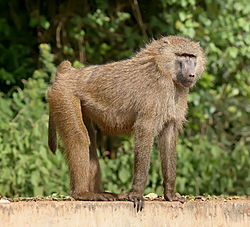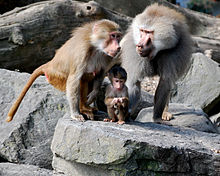Védett Föld
Föld és Természetvédelem: (Védett és kipusztult állatfajok - Védett növényeink) A Tasmán Tigris - (másnéven) - Az Erszényes Farkas. (Veszélyeztetettségi státusz: besorolás)
| Baboon - Pávián | |||||||||||||||||||||||||||||||||||||||||||||||||||||||||
|---|---|---|---|---|---|---|---|---|---|---|---|---|---|---|---|---|---|---|---|---|---|---|---|---|---|---|---|---|---|---|---|---|---|---|---|---|---|---|---|---|---|---|---|---|---|---|---|---|---|---|---|---|---|---|---|---|---|
 |
|||||||||||||||||||||||||||||||||||||||||||||||||||||||||
| Olive Baboon | |||||||||||||||||||||||||||||||||||||||||||||||||||||||||
| Scientific classification | |||||||||||||||||||||||||||||||||||||||||||||||||||||||||
| Kingdom: | Animalia |
||||||||||||||||||||||||||||||||||||||||||||||||||||||||
| Phylum: | Chordata |
||||||||||||||||||||||||||||||||||||||||||||||||||||||||
| Class: | Mammalia |
||||||||||||||||||||||||||||||||||||||||||||||||||||||||
| Order: | Primates |
||||||||||||||||||||||||||||||||||||||||||||||||||||||||
| Family: | Cercopithecidae |
||||||||||||||||||||||||||||||||||||||||||||||||||||||||
| Genus: | Papio Erxleben, 1777 |
||||||||||||||||||||||||||||||||||||||||||||||||||||||||
| Type species | |||||||||||||||||||||||||||||||||||||||||||||||||||||||||
| Simia hamadryas Linnaeus, 1758 |
|||||||||||||||||||||||||||||||||||||||||||||||||||||||||
| Species | |||||||||||||||||||||||||||||||||||||||||||||||||||||||||
|
Papio hamadryas |
|||||||||||||||||||||||||||||||||||||||||||||||||||||||||
| Synonyms | |||||||||||||||||||||||||||||||||||||||||||||||||||||||||
Baboons are African and Asian Old World monkeys belonging to the genus Papio, part of the subfamily Cercopithecinae. There are five species, which are some of the largest non-hominid members of the primate order; only the Mandrill and the Drill are larger. Previously, the closely related Gelada (genus Theropithecus) and two species of Mandrill and Drill (genus Mandrillus) were grouped in the same genus, and these Old World monkeys are still often referred to as baboons in everyday speech. They range in size and weight depending on species. The Guinea Baboon is 50 cm (20 inches) and weighs only 14 kg (30 lb) while the largest Chacma Baboon can be 120 cm (47 inches) and weigh 40 kg (90 lb). A group of baboons is collectively called a troop or congress. Magyar Ismertető: A páviánok a Papio nembe tartozó óvilági majmok, amelyek Afrikában és egy kis területen az Arab-félszigeten fordulnak elő. Meglehetősen nagytermetű, nagy csapatokban élő, mindenevő főemlősök. Hagyományosan öt fajukat különböztetik meg, ám ezt a felosztást számos kutató elveti – sokak szerint csak 2, mások szerint viszont 7 faj tartozik ide. A genetikai vizsgálatok a nem tagjai esetében még gyerekcipőben járnak, így egyelőre nincsenek megnyugtató eredmények. A név eredeteAz állat tudományos neve, a Papio a vörös páviánt jelentő középkori eredetű spanyol papión szóból származik, amelyet e faj neveként a francia az angol nyelv is átvett és mindmáig használ. A szó eredete egyébként egy afrikai helyi elnevezés lehetett, amely kapcsolatban állhatott az ókori egyiptomi páviánistenség, Babi alakjával. A papion szóból keletkezhetett azután a francia babouin név (a „grimasz” jelentésű francia babou szóval való hasonlóság hatására), amit Georges-Louis Leclerc francia természettudós használt először a páviánok tudományos neveként (Histoire naturelle, 1749-1788). A magyarba a holland Baviaan és német Pavian útján került a szó.
|
|||||||||||||||||||||||||||||||||||||||||||||||||||||||||
Honlapkészítés ingyen:
Ez a weblapszerkesztő alkalmas
ingyen weboldal,
ingyen honlap készítés...
Mai: 367
Tegnapi: 333
Heti: 1 200
Havi: 10 655
Össz.: 1 181 424
Látogatottság növelés
Védett Föld - © 2008 - 2025 - vedettfold.hupont.hu




